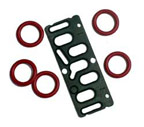
|
7108
S. Alton Way, Unit I |
(303) 758-2728
Home > Elastomers > Material Chart
O-Ring
and Seal
|
|
Elastomer
& Temperature
|
Applications |
Use With These Fluids |
Do Not Use With These Fluids |
| Simriz® -10 C to +305 C Compound Specific |
Simriz® orings are molded of an elastomer that has the broadest chemical resistance of any elastomer. They combine the resilience and sealing force of an elastomer with chemical resistance approaching that of FEP. | most chemicals | --- |
| Aflas® -10 C to +204 C Compound Specific |
Aflas® is a unique fluoroelastomer resistant to petroleum oils, steam, hydrogen sulfide and amine corrosion inhibitors. This compound is generally used for sour gas oil field services. | petroleum oils, H2S, steam | acetone, lacquers |
| Carboxilated
Nitrile -54 C to +135 C |
A nitrile elastomer with low temperature and excellent abrasion resistance. Commonly used in Downhole applications. | petroleum oils, water | brake fluid, phosphate esters |
| FKM Fluorocarbon, Viton® -40 C to +204 C Compound Specific |
Featuring excellent resistance to petroleum products and solvents, with good high temperature and low compression set characteristics. For use with wide chemical exposure situations, and with low gas permeability, it is also suited for hard vacuum service. | petroleum oils, gasoline, transmission fluid | acetone, H2S, hot water, amines |
| Ethylene
Propylene -54 C to +150 C |
Ethylene Propylene has excellent ozone and chemical resistance characteristics. Generally used in automotive brake systems. | brake fluids, refrigerants, steam | petroleum oils, diester lubricants |
| Fluorosilicone -56 C to +204 C |
Fluorosilicone combines the good high and low temperature stability of silicone with the fuel, oil, and solvent resistance of fluorocarbon. | petroleum oils, gasoline | acetone, ethyl acetate |
| Highly
Saturated Nitrile (HSN, HNBR) -26 C to +160 C |
A nitrile elastomer with excellent resistance to petroleum oils, and sour gas. With the extended temperature range, HSN is becoming a preferred compound in the oil patch. | petroleum oils, H2S, CO2 | brake fluid |
| Neoprene -40 C to +135 C |
Due to its excellent resistance to freon and ammonia, Neoprene is widely accepted as a preferred elastomer for refrigeration seals. | refrigerants, alcohol, ozone | petroleum oils, Toluene |
| Nitrile
(Buna-N) -40 C to +135 C Nitrile (Low-Temp) -65 C to +120 C |
Presently the seal industry's most widely used elastomer. Nitrile combines excellent resistance to petroleum based oils and fuels, silicone greases, hydraulic fluids, water and alcohols. It has a good balance of working properties such as low compression set, high tensile strength, high abrasion resistance, combined with a low cost. | petroleum
oils, water, hydraulic oils |
brake
fluid, ketones, phosphate esters, H2S |
| Polyurethane -40 C to +105 C |
An excellent elastomer with high abrasion resistance characteristics and high tensile strength. Used in high pressure hydraulic systems where highly stressed parts are subject to wear. | petroleum
oils, hydraulic oils |
brake fluid |
| Silicone -65 C to +260 C |
Silicone elastomer is resistant to high, dry heat, in primarily static applications. It has low compression set characteristics and a wide temperature range. | dry heat, alcohol, vegetable oil | petroleum oils & fuels |
| FEP -20 C to +204 C |
FEP is a tough, chemically inert elastomer possessing an incredible working range. For static and slow intermittent dynamic situations. FEP is hampered only by it's poor memory at low temperature. | most chemicals | --- |
Data is presented for use only as a general guide and should not be the basis for design decisions. If you need help choosing the right material for your application, just give us a call at 303-758-2728.
Viton® was a registered trademark of DuPont at the time the article was written and is now a registered trademark of the Chemours Company.
Next Topic Common Polymers in Semiconductor Process Equipment
We are located in the Denver Technological
Center in a suburb of Denver, Colorado
©1997-2017, Problem Solving Products, Inc.
Website Map | Privacy Statement
| Terms of Use

